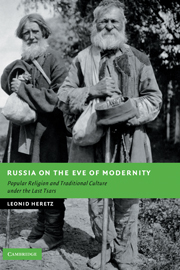Book contents
- Frontmatter
- Contents
- Acknowledgments
- Introduction
- 1 The traditional worldview
- 2 The Old Believers: modernization as apocalypse
- 3 The sectarians: dualism and secret history
- 4 Folk eschatology
- 5 The assassination of Alexander II (1881) and folk Tsarism
- 6 The year of famine and cholera (1891–1892): demonization of the nobility
- 7 The Japanese War: peasant Russia and the wider world
- 8 1905: revolution or reaction?
- 9 The Great War and the crisis of the traditional culture
- Epilogue
- Bibliography
- Index
- NEW STUDIES IN EUROPEAN HISTORY
3 - The sectarians: dualism and secret history
Published online by Cambridge University Press: 23 December 2009
- Frontmatter
- Contents
- Acknowledgments
- Introduction
- 1 The traditional worldview
- 2 The Old Believers: modernization as apocalypse
- 3 The sectarians: dualism and secret history
- 4 Folk eschatology
- 5 The assassination of Alexander II (1881) and folk Tsarism
- 6 The year of famine and cholera (1891–1892): demonization of the nobility
- 7 The Japanese War: peasant Russia and the wider world
- 8 1905: revolution or reaction?
- 9 The Great War and the crisis of the traditional culture
- Epilogue
- Bibliography
- Index
- NEW STUDIES IN EUROPEAN HISTORY
Summary
Although the majority of its Russian subjects were members of the “official” Orthodox Church, Imperial Russia generated a great variety of religious dissident groupings. These religious forms are in themselves a fascinating field for inquiry, and familiarity with them is essential for an adequate understanding of Russian culture. Insofar as historians have paid attention to the topic, it has been the usual practice to categorize the “sectarians” as being in sharp and total distinction to Orthodoxy. This approach derives from the nineteenth century, when the literary-propagandistic efforts of two mutually antagonistic groups – the radical opposition and the Orthodox clergy – created the standard picture of the Russian sectarian as the enemy of Orthodoxy and established order. The pre-revolutionary intelligentsia was quite correct in seeing the Orthodox Church as a bulwark of autocracy, but it deluded itself when it assumed that dissent from the Church was a total rejection of Orthodoxy and therefore a harbinger of a fervently awaited general popular rejection of Tsarism. Conversely, the Orthodox clergy was justified in seeing dissent as a repudiation of ecclesiastical authority and separation from the Church, but wrong in portraying it as a complete break with piety and a first step to open sedition. From a cultural–historical perspective, the picture is quite different – rather than setting off in radically-new directions, the various sects took specific elements of the general traditional culture to their extreme and thereby offered vivid illustrations of the underlying (and oftentimes obscured) tendencies of that culture.
- Type
- Chapter
- Information
- Russia on the Eve of ModernityPopular Religion and Traditional Culture under the Last Tsars, pp. 76 - 101Publisher: Cambridge University PressPrint publication year: 2008



